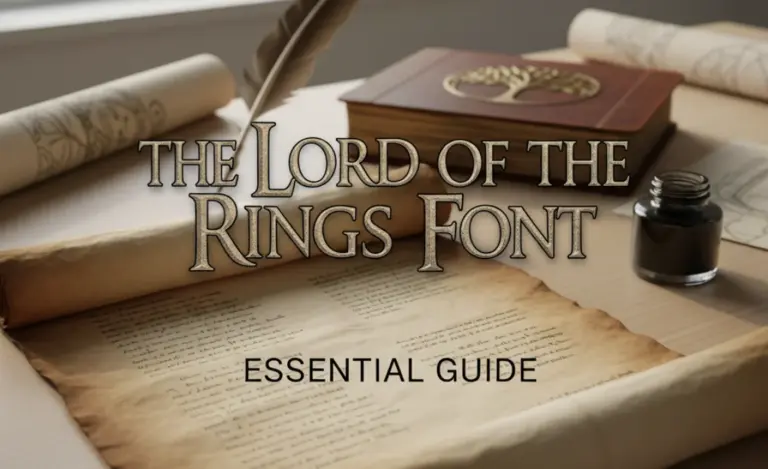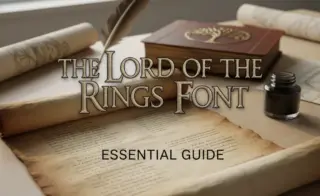Antique Olive Font: Your Essential Guide to Timeless Design
Looking for an antique olive font that blends vintage charm with modern appeal? This guide unlocks the secrets of using Antique Olive font effectively for logos, branding, and design projects. Discover its history, best pairings, and practical tips for a timeless look that captivates your audience.
Welcome, design lovers! Ever feel like finding the perfect font is a bit like searching for a hidden treasure? You stumble upon styles that look interesting, but then you realize they just don’t quite fit your project’s vibe. That’s where fonts like Antique Olive come in. They have this wonderful way of feeling familiar yet unique, like a beloved story retold. If you’re aiming for a design that’s both classic and current, you’re in the right place. We’re going to dive deep into the world of the Antique Olive font, making sure you know exactly how to use it to make your designs shine. Get ready to transform your creative projects with this versatile typeface!
What Exactly is the Antique Olive Font?
Antique Olive is a sans-serif typeface family designed by Roger Excoffon in the early 1960s. Unlike many geometric sans-serifs of its era, Antique Olive boasts a distinctly humanist touch. It’s known for its slightly condensed, yet open, forms and its warm, inviting character. Each letter feels carefully crafted, with subtle variations that give it a distinctive personality.
The “Olive” in its name is a nod to the somewhat organic, rounded shapes that appear throughout the alphabet, especially in characters like ‘o’, ‘c’, and ‘e’. It was initially designed for the French Typefoundry Fonderie Olive, and its enduring popularity speaks volumes about its design quality. It’s a typeface that bridges the gap between the seriousness of its older sans-serif cousins and the more playful designs emerging at the time.
The History and Design Philosophy Behind Antique Olive
Roger Excoffon was a visionary type designer. He believed that typefaces should have a personality, a story to tell. With Antique Olive, he aimed to create a font that was both functional for everyday text and striking enough for headlines and display use. This duality is one of its greatest strengths.
Excoffon’s design philosophy often embraced a handcrafted feel, even within the structured world of sans-serif typography. He was known for his spirited approach, and Antique Olive reflects this. It was designed during a period when graphic design was rapidly evolving, and Excoffon was at the forefront, pushing boundaries. The slight irregularities and the subtle curves in its letterforms give it a friendly, almost conversational tone, making it approachable for a wide range of applications. You can find more about Roger Excoffon’s influential work and philosophy through resources like the AIGA Medalist profile on Roger Excoffon.
Why Antique Olive is a Design Gem
So, what makes Antique Olive so special? It’s a combination of factors that contribute to its lasting appeal:
- Unique Character: It’s not just another generic sans-serif. The distinctive shapes and proportions give it a memorable personality.
- Versatile Weights: Available in a range of weights from delicate to bold, allowing for great flexibility in design.
- Exceptional Readability: Despite its distinctiveness, Antique Olive remains highly readable, making it suitable for both body text and headlines.
- Timeless Appeal: It avoids fleeting trends, offering a classic look that feels current regardless of the era.
- Humanist Touch: The subtle curves and open forms give it a friendly and approachable feel.
Exploring the Antique Olive Font Family
The Antique Olive font family, as originally conceived and later expanded, offers several variations, each with its own subtle nuances. Understanding these different weights and styles can significantly enhance your design choices.
Typically, you’ll find Antique Olive in the following versions:
| Weight | Typical Use Cases | Characteristics |
|---|---|---|
| Antique Olive Regular | Body text, general headings, paragraphs | Balanced, clear, and unobtrusive. The workhorse of the family. |
| Antique Olive Bold | Headlines, subheadings, emphasis | Stronger contrast, commands attention without being overpowering. |
| Antique Olive Italic | Emphasis, quotes, longer passages that need distinction | Slanted version of Regular, maintains legibility. |
| Antique Olive Black/Heavy | Large display headlines, impactful statements | Maximum impact, designed for short bursts of text. |
| Antique Olive Condensed/Light | Captions, sidebars, when space is limited | More compact, can offer a different feel for specific uses. |
When choosing a weight, consider the hierarchy you want to establish in your design. A clear visual hierarchy guides the reader’s eye and makes your content much easier to digest. For instance, using Antique Olive Bold for main titles and Antique Olive Regular for the body text creates an immediate distinction that’s both functional and aesthetically pleasing.
How to Use Antique Olive Font Effectively in Your Designs
Using Antique Olive is about understanding its strengths and applying them thoughtfully. Here are some practical tips to get you started:
1. For Logos and Branding
Antique Olive’s unique character makes it a fantastic choice for logos, especially for brands aiming for a retro, artisanal, or established feel. Its humanist sans-serif nature provides a sense of approachability and authenticity.
- Consider the Context: Does the brand’s personality align with Antique Olive’s warm, slightly vintage vibe? Think about industries like food and beverage, lifestyle products, or even publishing houses that want a classic but friendly image.
- Weight Selection is Key: For a logo, a bolder weight like Antique Olive Bold or even Black often works well to ensure legibility at various sizes. However, a very condensed version might be used for a specific wordmark to create a compact and impactful logo.
- Pair with Clear Imagery: Keep the accompanying graphics or illustrations clean and complementary to avoid an overly cluttered look.
2. For Website Design and Blogs
Readability is paramount on the web, and Antique Olive shines here. It feels grounded and trustworthy, perfect for conveying information.
- Body Text: Use the Regular or Light weights for paragraphs to ensure comfortable reading. Its open letterforms prevent eye strain.
- Headings: The Bold or Semibold weights are excellent for headings and subheadings. They provide clear visual breaks without being too aggressive.
- Hierarchy: Establish a clear typographic hierarchy using different weights and sizes of Antique Olive. For example, use a large, bold weight for the page title, a slightly smaller bold for section headers, and regular for content.
- Pairing Fonts: Antique Olive pairs beautifully with serif fonts that have a classic feel, or with more minimalist sans-serifs for contrast.
3. For Print Materials
Whether it’s brochures, posters, book covers, or signage, Antique Olive offers a sophisticated yet accessible presence.
- Impactful Headlines: Use the heavier weights for headlines on posters or book jackets to grab attention. The unique letterforms make them stand out.
- Editorial Content: For magazines or newspapers, Antique Olive can be used for body text to give a classic, established feel, or for pull quotes to add visual interest.
- Packaging: Its warm character makes it suitable for product packaging, conveying quality and a touch of artistry.
4. For Display and Creative Use
Beyond standard text, Antique Olive can be a playful element in more experimental designs.
- Thematic Designs: Its vintage undertones are perfect for projects with a mid-century modern or retro theme.
- Creative Combinations: Experiment with overlapping letters or unique spacing to create artistic effects.
Pairing Antique Olive Font with Other Typefaces
The art of typography often lies in successful pairings. Antique Olive, with its distinct personality, can either stand alone harmoniously or complement other fonts beautifully. Here are some pairing ideas:
1. Serif Pairings: Classic Harmony
For a timeless, elegant feel, pairing Antique Olive with a classic serif font is a winning strategy. The contrast between sans-serif and serif creates visual interest while maintaining a sense of tradition.
- Garamond: A ubiquitous and elegant serif, Garamond offers a beautiful contrast to Antique Olive’s sans-serif forms. Use Antique Olive for headings and Garamond for body text for a refined editorial look.
- Times New Roman: While common, Times New Roman still possesses a sturdy, classic presence. Pairing it with Antique Olive can create a dependable and readable combination.
- Merriweather or Lora: These are more contemporary serifs with a friendly feel that can echo Antique Olive’s humanist qualities, creating a cohesive yet contrasting design.
2. Sans-Serif Pairings: Modern Synergy
When aiming for a modern, clean aesthetic or a subtle variation in style, pairing Antique Olive with other sans-serifs can work wonders.
- Helvetica/Arial: While Antique Olive has more personality, pairing it with a more neutral sans-serif like Helvetica or Arial can create a sophisticated contrast. Use Antique Olive for key display elements and a cleaner sans for supporting text.
- Futura: Known for its geometric purity, Futura can offer a crisp counterpoint to Antique Olive’s more organic curves.
- Open Sans/Lato: These are popular, legible, and friendly sans-serifs that can complement Antique Olive well, especially for web content where readability is key.
3. Script and Display Pairings: Creative Flair
For a more artistic or decorative touch, Antique Olive can be paired with scripts or more decorative display fonts, but caution is needed.
- Elegant Scripts: Use a sophisticated script for accents or special call-outs, ensuring it doesn’t compete with Antique Olive’s presence.
- Handwritten Fonts: If your brand has an artisanal or personal feel, a complementary handwritten font can work, but choose one that doesn’t clash with Antique Olive’s unique letterforms.
Where to Find and License Antique Olive Font
Antique Olive is a classic typeface, and like many beloved fonts, it has seen various iterations and become available through different foundries. It’s important to choose a reputable source to ensure you have the correct licensing and a high-quality digital version of the font.
You can often find Antique Olive or its derivatives through major font marketplaces and foundries. Some popular places include:
- Adobe Fonts: If you are an Adobe Creative Cloud subscriber, Antique Olive is usually available within the Adobe Fonts library, offering a simple licensing model for personal and commercial use.
- Linotype/Monotype: These are historical and prominent type foundries that often carry classic typefaces like Antique Olive. They offer robust versions with comprehensive licensing options.
- Google Fonts: While not always listing the original Antique Olive, Google Fonts has a vast library of similar humanist sans-serifs that offer comparable aesthetics and are completely free for commercial use. Examples might include fonts like ‘Source Sans 3’ or ‘Open Sans’ which share some of its approachable qualities.
When licensing, always check the terms of use. Different licenses are available for desktop use, web use, app use, and more. For branding and commercial projects, a commercial license is essential. Understanding font licensing is crucial for avoiding legal issues, and resources like the U.S. Copyright Office provide foundational information on copyright protection for creative works.
Pros and Cons of Using Antique Olive Font
Like any typeface, Antique Olive has its strengths and potential weaknesses. Being aware of these will help you make informed design decisions.
| Pros | Cons |
|---|---|
| Unique Character: Stands out from generic sans-serifs, offering a memorable identity. | Potential Overuse: Its popularity means it can sometimes feel common if not used creatively. |
| Excellent Readability: Well-suited for both headlines and body text across digital and print media. | Specific Vibe: Its mid-century modern/retro feel might not suit highly futuristic or minimalist brands. |
| Versatile Weights: A good range of weights allows for strong typographic hierarchy. | Licensing Costs: While widely available, some high-quality versions may require purchase and licensing fees. |




Leave a Comment